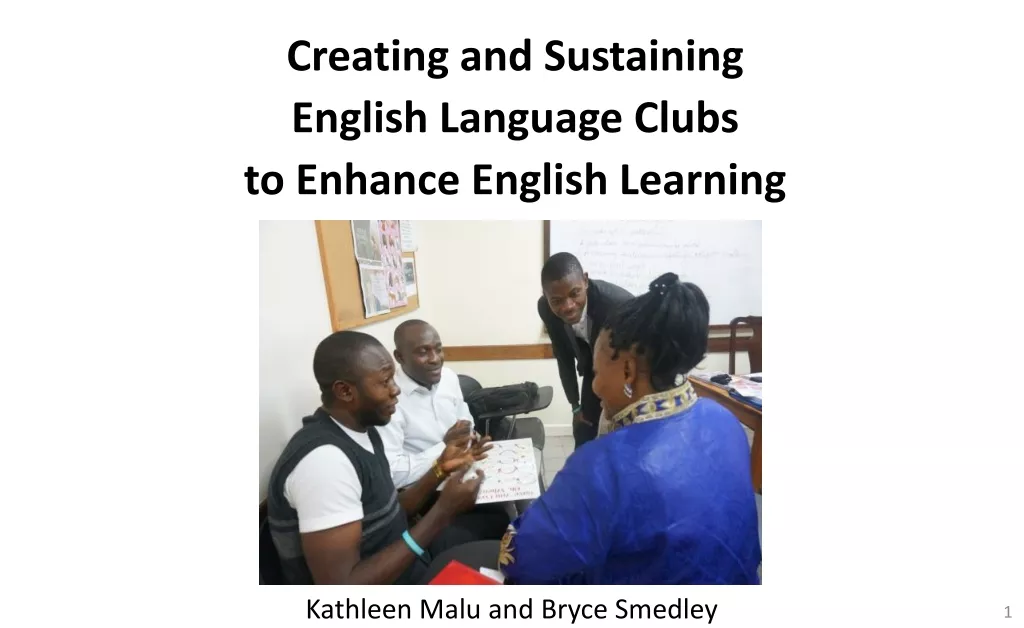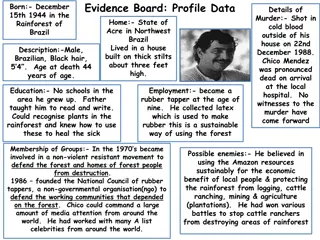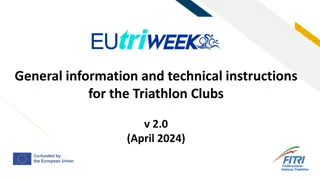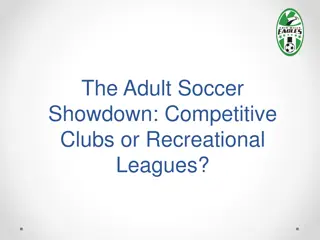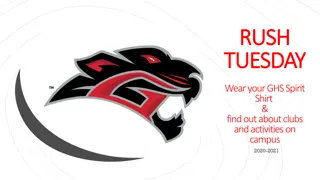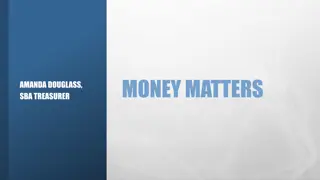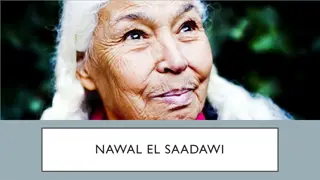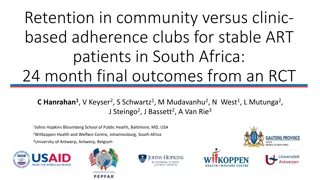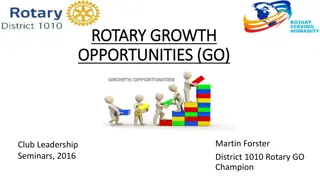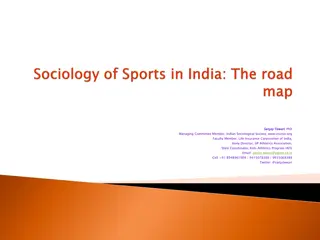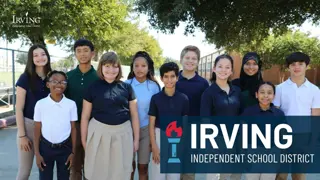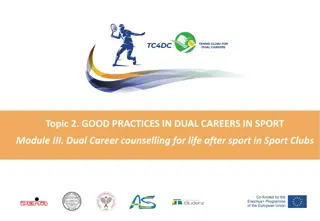Sport Clubs Embracing New Activist Role
A scoping review on how sport clubs are incorporating activism into their roles, exploring the potential for broader societal change. The study highlights the importance of sports clubs in promoting social responsibility and positive community impact.
Uploaded on Mar 13, 2025 | 0 Views
Download Presentation

Please find below an Image/Link to download the presentation.
The content on the website is provided AS IS for your information and personal use only. It may not be sold, licensed, or shared on other websites without obtaining consent from the author.If you encounter any issues during the download, it is possible that the publisher has removed the file from their server.
You are allowed to download the files provided on this website for personal or commercial use, subject to the condition that they are used lawfully. All files are the property of their respective owners.
The content on the website is provided AS IS for your information and personal use only. It may not be sold, licensed, or shared on other websites without obtaining consent from the author.
E N D
Presentation Transcript
Sport clubs: the future of activism? A scoping review highlighting how sport clubs are embracing a new role 13th International Conference on Sport & Society Aarhus University, Denmark June 30th July 1st, 2022 Eva Wolzok, PhD Candidate
Outline Research Context Future Research
INTRODUCTION Globalisation and an increasingly connected world have led to a rapid growth in the phenomenon of activism through sport. Existing Research Highlights individual athletes using their platforms, for example: LeBron James against racism; Colin Kaepernick for Black Lives Matter; Naomi Osaka for mental health; and Megan Rapinoe and LGBTQ+ rights and gender equality. (Galily, 2019; Boykoff and Carrington, 2019; Leppard, 2022; Schmidt, Frederick, Pegoraro and Spencer, 2018). Highlights specific leagues where CSR is prevalent, for example: NCAA athletic departments in the USA and environmental responsibility (Trendafilova, Pfahl & Casper, 2013:114). Research outlines environmental activities such as recycling, energy usage, water usage, food waste, recycling tonnage are measurable which means that profit can be potentially calculated, and activities can be evaluated and improved. These researchers push for case-oriented studies which allow for in-depth analysis of the phenomena and comparisons which lead to answers. Gap in Existing Research: While a rise has been seen in research concerning individual sporting figures and activism, the area of sporting institutions and activism remains largely unexplored.
RESEARCH QUESTIONS This research aims to answer the following questions: 1. How have they been discussed in the literature thus far? 2. Who are the sport clubs leading activism? 3. What are the types of activism they carry out? This paper is focused on answering Question 1. Questions 2 and 3 will be explored in a larger piece of research as part of my thesis.
JUSTIFICATION During the past 30 years, there has been a significant growth in CSR, not only in the corporate sector but also within the sport industry. Philanthropy is important but no longer good enough, with clubs putting more resources in community initiatives (Babiak and Wolfe, 2009; Walker and Kent, 2009). Coalter (2007) warns organisations that benefits attached to sport crime reduction, health improvement, social inclusion, growth in social capital are neither a given nor automatic. Sport is central to society and clubs are often community bounding, therefore it has become part of the DNA of sport clubs to be socially responsible, transparent, and accountable to their community (Babiak and Wolfe, 2009). The whole sector of sport is becoming more accountable, with clubs being answerable to their communities. With that in mind, a case-study approach to 3 clubs has been undertaken to see how they have made CSR integral in their club culture and not simply a tokenistic club activity. Given the impact of activism and advocacy led by individual sporting figures, this article posits that sports clubs and sporting institutions may hold further potential in enacting sustainable positive change within their own communities. With the prospective of greater connectivity and a wider reach, sporting institutions may be posited as vehicles for broader, systemic social change.
METHODOLOGY Through a scoping review, comprising of both academic journals and grey literature, identification of this new phenomenon is explored. By using a scoping review, it enables a high volume of information to be synthesised, providing an overview of what has been investigated thus far and giving direction to future research.
THEORETICAL FRAMEWORKS A. Davis-Delano and Crosset (2008:116) explain how sport is a useful stage to convey a message which has been seen many times in the past. They carried out a comparative study of successful and unsuccessful social movements carried out by activists but also compared the initiatives by time, space and type of social movement. For example, Russian athletes being banned from certain sporting competition as an act of standing up to Russia over their invasion of Ukraine i. B. Schmidt (2018) discussed activism in sport through media by using cultivation theory. Gerbner (1999) explains that the way we understand the world is not through our personal experience but rather through what we hear and see. Therefore, it can be assumed that the way we understand reality is shaped by our media exposure. This in turn gives great power to individual sport clubs who operate their own media channels, creating their own persona and influencing how and what we hear and see. How sport clubs help cultivate perspective of sexuality, gender, age, politics? i. C. Babiak and Wolfe (2009) highlight the four features (passion, economics, transparency and stakeholder) that make sport unique with respect to CSR. Additionally, they identify six professional sport-relevant pillars: Labour relation: paying employees equitably, providing a safe work environment, social care benefits, opportunities for growth. Environmental management & sustainability: recycling, developing environmental solutions. Community relations: supporting the community through providing financial support, facilities, open doors, programs for people to engage with. Philanthropy: creating a team-affiliated charitable foundation which makes outreach efforts on behalf of the club. Diversity and equity: reflecting the society in which the club operates, where views, experiences and perspectives are included regardless of gender, sexuality, disability, race and so on. Corporate governance: being socially responsible with regard to the management, owners and board of directors of a club. i. ii. iii. iv. v. vi.
THEORETICAL FRAMEWORKS cont. Those six pillars, as complex as they may seem, can all be part of a clubs CSR initiatives. Following those, Babiak and Wolfe (2009), created an integrative framework of the impact of CSR in sport. This works along two dimensions: 1. a unit of analysis dimension referring to the beneficiaries of the CSR activity, from individual to community. 2. the other unit if the timing of impact dimension referring to intermediate to long-term. As a result, four impact boxes make up the structure of the framework: Intermediate individual impact: to what extent does participating in the program change the participant behaviour and acquisition of knowledge. Intermediate community impact: the total of the intermediate individual impact of a program on the community where it is implemented. Therefore, the level of impact and the number of participants reached. Long-term individual impact: the desired state of physical, psychological and/or living conditions that individual participants would achieve by continuously engaging in the behaviour promoted in a CSR program. Calculated by comparing a non-participating group with program participants. Long-term community impact: concrete cultural and infrastructural changes which have shown benefits to the community due to long-term individual impact of a CSR program.
RESEARCH QUESTION: How have they been discussed in the literature thus far? Activism and the Individual Athlete Colin Kaepernick, LeBron James, Megan Rapinoe, and Naomi Osaka This is not a new phenomenon. Mohammed Ali, Tommie Smith and John Carlos Candaele and Dreir (2004) notes that this often comes with the stigma of being a jock for justice and athletes can be criticised for taking a stand for their beliefs. Athletes, are first and foremost citizens, as Kaufman and Wolff (date: 166) explain who have the responsibility to be aware of global events and who should be allowed, and even encouraged, to assert their voice in the political arena . Leppard (2022: 2) adds to the discussion on highlighting the differences between athletes that are part of a team and those who play an individual sport using the case of Naomi Osaka. He states that as an individual athlete she has fewer barriers that stymie her voice whilst athletes who are part of a team are constrained by contracts and must adhere to certain codes imposed upon them by their clubs (Seebruck and Savage, 2014). However even here, we are seeing changes, as was seen within the French national football team and Kylian Mbappe s fight for his own right to image in the spring of 2022.
RESEARCH QUESTION: How have they been discussed in the literature thus far? There are different layers to activism, however at its simplest, it is best understood as: actors campaigning to raise awareness or mobilize a group towards social change (Leppard 2022:3) Sport-based activism refers to: specific actions taken by athletes to alter and mitigate the hegemonic nature of structural arrangements, rules/policies/bylaws, and practices through sport organizations that serve to reinforce subordination, marginalization, and exploitation of certain groups (Cooper et al. 2019:22) Social responsibility is the: responsibility of enterprises for their impacts on society (European Commission 2011: 6).
RESEARCH QUESTION: How have they been discussed in the literature thus far? The Role of the Media Schmidt s (2018:12) paper on the relationship between the media and reporting activism in sport brings to light the implication that sport-based activism could have for society, he states: such crossover can help spread acceptance of different perspectives, lifestyles, and viewpoints among an audience that otherwise might have been insulated from outside viewpoints He mentions how data reinforces the central place of sport in people s life by showing that topics discussing activism were higher in sport media than in news media. Schmidt explains that through media coverage, an increased sense of civic responsibility is seen as people are consuming sport news that are interlinked with activism, reflecting a world where acceptance of different perspectives, lifestyles and viewpoints are spreading, promoting understanding and social awareness.
IMPLICATIONS How CSR is being done now Waddington, Chelladurai and Skistad (2013) highlight that CSR policies are carried out in three ways: 1. Through charitable donations; 2. Local community projects; and 3. CSR policies adopted by international sports organisations. Number 3 is not as relevant to local sport clubs. Number 1 is easy to monitor and evaluate as it is often calculated in terms of dollars of volunteer hours. Number 2 is where the meat of the matter lies as it is much more difficult to evaluate. They state that such schemes are usually characterized by an absence of any built-in monitoring in terms of which their effectiveness can be judged" (Waddington, Chelladurai and Skistad, 2013:43). Additionally, local community projects are often claimed to have massive impacts upon communities with little proof that this is the case in the long-term. As Coalter (2007) mentions, thorough evaluations are rare within initiatives linked with sport as we attach the idea that sport equals benefits, regardless of what is being done. Therefore as Coalter (2007) notes, we need to be more analytical and less emotional when designing, implementing, monitoring and evaluating sport-based programs if we want to have real positive impacts on communities.
IMPLICATIONS Sport & its potential Sport clubs are different from other businesses, as owners may have different objectives than financial gain, including winning, the protection of a community asset, and the trophy status of owning a team (Inoue et al., 2011:547). Of interest are the relationships clubs have with their fans, as the fans display a high level of affect toward their clubs. Walker and Kent mention where cultivation of an affective connection to the organization is critical, CSR may provide secondary value for the organization over and above those which have been seen in other industries (2009: 744). This specific relationship is where lies the potential of sport to generate passion and concrete long-term change within the club but also the behaviour of their own fans and larger community. CSR evaluating it differently CSR initiatives so far have been mainly evaluated in terms of their instrumental benefits for the company, Margolis and Walsh (2003: 280-3) state we never learn about their impact on society, most notable on the intended beneficiaries of those initiatives. Therefore, if we were to change our focus by seeing the effects it has on society and ask questions such as: To what extent are programs effective? How do we measure the significance of the impact in achieving the aims of the programs? Is the initiative having a long-term impact?
Graduate Institute of Sport, Hospitality and Leisure Management National Taiwan Normal University Taipei Taiwan eva.wolzok@gmail.com
References Armey, C. (2004). Inside and outside: Corporate America vs. the sports industry. In M. Falls (Ed.), Inside the Minds: The Business of Sports (pp. 65-80). Boston: Aspatore, Inc: Babiak, K., & Wolfe, R. (2006). More than just a game? Corporate social responsibility and Super Bowl XL. Sport Marketing Quarterly, 15, 214-224. Babiak, K. and Wolfe, R. (2006) More than just a game? Corporate social responsibility and Super Bowl XL . Sport Marketing Quaterly, 15 (4), 214-222. Babiak, K. and Wolfe, R. (2009) Determinants of corporate social responsibility in professional sport: Internal and external factors , Journal of Sport Management, 23 (6), 528-549. BBC. (2008, October 17). 1968: Black athletes make silent protest. Retrieved from http://news.bbc.co.uk/onthisday/hi/dates/stories/october/17/newsid_3535000/3535348.stm Boykoff, J., & Carrington, B. (2019). Sporting dissent: Colin Kaepernick, NFL activism, and media framing contests. International Review for the Sociology of Sport, 55(7), 829-849. https://doi.org/10.1177/1012690219861594 Candaele, K., & Dreier, P. (2004, June 28). Where are the jocks for justice? Nation, 278(25), 21-24. Coalter, F. (2007) A wider social role for sport: Who s keeping the score? London: Routledge. Conway, S. (2016, January 20). Do sports and politics mix? Sports CheatSheet. Retrieved from http://www.cheatsheet.com/sports/should-athletes- get-involved-in-politics.html/?a=viewall Davis-Delano, L. R., & Crosset, T. (2008). Using social movement theory to study outcomes in sport-related social movements. International Review for the Sociology of Sport, 43(2), 115-134. https://doi.org/10.1177/1012690208095375 European Commission. 2011. A Renewed EU Strategy 2011-14 for Corporate Social Responsibility. Brussels, Belgium: European Commission. Galily, Y. (2019). Shut up and dribble! ?Athletes activism in the age of Twittersphere: The case of Lebron James. Technology in Society, 58, 101109. https://doi.org/10.1016/j.techsoc.2019.01.002 Gerbner, G. (1999). Forward by George Gerbner: What do we know? In J. Shanahan & M. Morgan (Eds.), Television and its viewers (pp. ix xii). Cambridge, UK: Cambridge
References Inoue, Y., Kent, A. and Less, S. (2011) CSR and the bottom line: analyzing the link between CSR and financial performance for professional teams , Journal of Sport Management, 25 (6), 531-549. J.N. Cooper, C. Macaulay, S.H. Rodriguez, Race and Resistance: A Typology of African American Sport Activism, International Review for the Sociology of Sport, 2017 1012690217718170. Kaufman, P., & Wolff, E. A. (2010). Playing and protesting: Sport as a vehicle for social change. Journal of Sport and Social Issues, 34(2), 154- 175. https://doi.org/10.1177/0193723509360218 Leppard, T. R. (2022). Athlete activism and the role of personal and professional positionality: The case of Naomi Osaka. International Review for the Sociology of Sport, 101269022110739. https://doi.org/10.1177/10126902211073907 Margolis, J. D. and Walsh, J. P. (2003) Misery loves companies: rethinking social initiatives by business , Administrative Science Quarterly, 48 (2), 268-305. Schmidt, H. C. (2018). Sport reporting in an era of activism: Examining the intersection of sport media and social activism. International Journal of Sport Communication, 11(1), 2-17. https://doi.org/10.1123/ijsc.2017-0121 Schmidt, S. H., Frederick, E. L., Pegoraro, A., & Spencer, T. C. (2018). An analysis of Colin Kaepernick, Megan Rapinoe, and the national anthem protests. Communication & Sport, 7(5), 653-677. https://doi.org/10.1177/2167479518793625 Seebruck R and Savage SV (2014) The differential effects of racially homophilous sponsorship ties on Job opportunities in an elite labor market: The case of NCAA basketball coaching. Sociological Inquiry 84(1): 75 101. Trendafilova, S., Pfahl, M., & Casper, J. (2013). CSR and Environmental Responsibility: The Case Of NCAA Athletic Departments. In J. L. Paramio-Salcines, K. Babiak, & G. Walters (Eds.), Routledge handbook of sport and corporate social responsibility. Routledge. Waddington, I., Chelladurai, P., & Skirstad, B. (2013). Corporate Social Responsibility in Sport: Who Benefits?. In J. L. Paramio-Salcines, K. Babiak, & G. Walters (Eds.), Routledge handbook of sport and corporate social responsibility. Routledge. Wallace, C. (2004). An insider s look at and love for pro basketball. In M. Falls (Ed.), Inside the Minds: The Business of Sports. Boston, MA: Aspatore, Inc. Walker, M, and Kent, A. (2009) Do fans care? Assessing the influence of corporate social responsibility on consumer attitudes in the sport industry , Journal od Sport Management, 23, 743-769.


